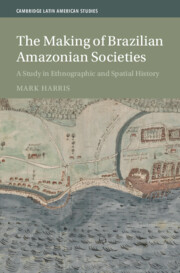
-
Select format
-
- Publisher:
- Cambridge University Press
- Publication date:
- November 2025
- November 2025
- ISBN:
- 9781009654050
- 9781009654104
- 9781009654067
- Dimensions:
- (229 x 152 mm)
- Weight & Pages:
- 0.653kg, 376 Pages
- Dimensions:
- (229 x 152 mm)
- Weight & Pages:
- 0.609kg, 376 Pages
You may already have access via personal or institutional login
Book description
Amazonia presents the contemporary scholar with myriad challenges. What does it consist of, and what are its limits? In this interdisciplinary book, Mark Harris examines the formation of Brazilian Amazonian societies in the seventeenth and eighteenth centuries, focusing predominantly on the Eastern Amazon, what is today the states of Pará and Amapá in Brazil. His aim is to demonstrate how the region emerged through the activities and movements of Indigenous societies with diverse languages, cultures, individuals of mixed heritage, and impoverished European and African people from various nations. Rarely are these approaches and people examined together, but this comprehensive history insightfully illustrates that the Brazilian Amazon consists of all these communities and their struggles and highlights the ways the Amazon has been defended through partnership and alliance across ethnic identities.
Reviews
‘This fabulous book takes the risk of situating itself in a watery and fluid space of improbable mediations to recount the formation of Amazonian riverbank societies in the 17th and 18th centuries. A must-read.’
Carlos Fausto - author of Art Effects: Image, Agency and Ritual in Amazonia
‘Our accumulated knowledge of Amazonian history and anthropology has deepened but also fragmented our understanding of this vast region. Harris’s remarkable interdisciplinary synthesis provides an essential, unifying interpretation of diverse Indigenous responses to early Portuguese colonization.’
Hal Langfur - author of Adrift on an Inland Sea: Misinformation and the Limits of Empire in the Brazilian Backlands
‘Mark Harris did it again. After telling us in Rebellion on the Amazon that Amazonian peoples fought a devastating war, lost it militarily, but won the right to preserve their ways of life, now he treats us to The Making of Brazilian Amazonian Societies, unveiling further those ways of life in their impressive diversity region wide. Like a nutshell, an Amazonian canoe, he says, reveals it all: ‘Within a canoe, there is an Amazonian world in miniature.’ It is the Amazon with a British accent. Splendid!’
Alcida Rita Ramos - author of Indigenism: Ethnic Politics in Brazil
‘In this boldly original work of historical anthropology, Harris reveals how diverse peoples in the Eastern Amazon created interconnected worlds via rivers and forest paths. Making room for multiple histories and bringing Indigenous perspectives to the forefront, this is interdisciplinary scholarship at its most compelling.’
Heather F. Roller - author of Contact Strategies: Histories of Native Autonomy in Brazil
Contents
Metrics
Full text views
Full text views help Loading metrics...
Loading metrics...
* Views captured on Cambridge Core between #date#. This data will be updated every 24 hours.
Usage data cannot currently be displayed.
Accessibility standard: WCAG 2.0 A
Why this information is here
This section outlines the accessibility features of this content - including support for screen readers, full keyboard navigation and high-contrast display options. This may not be relevant for you.
Accessibility Information
The PDF of this book conforms to version 2.0 of the Web Content Accessibility Guidelines (WCAG), ensuring core accessibility principles are addressed and meets the basic (A) level of WCAG compliance, addressing essential accessibility barriers.
Content Navigation
Table of contents navigation
Allows you to navigate directly to chapters, sections, or non‐text items through a linked table of contents, reducing the need for extensive scrolling.
Index navigation
Provides an interactive index, letting you go straight to where a term or subject appears in the text without manual searching.
Reading Order and Textual Equivalents
Single logical reading order
You will encounter all content (including footnotes, captions, etc.) in a clear, sequential flow, making it easier to follow with assistive tools like screen readers.
Short alternative textual descriptions
You get concise descriptions (for images, charts, or media clips), ensuring you do not miss crucial information when visual or audio elements are not accessible.
Full alternative textual descriptions
You get more than just short alt text: you have comprehensive text equivalents, transcripts, captions, or audio descriptions for substantial non‐text content, which is especially helpful for complex visuals or multimedia.
Structural and Technical Features
ARIA roles provided
You gain clarity from ARIA (Accessible Rich Internet Applications) roles and attributes, as they help assistive technologies interpret how each part of the content functions.

